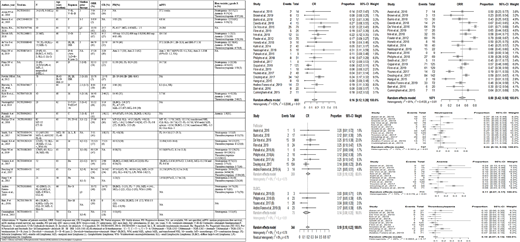Background: Phosphatidylinositol-3-Kinase (PI3K)-oncogenic protein kinase is ubiquitously expressed in cells, however, PI3Kδ and PI3Kγ are selectively expressed in hematopoietic cells predominantly in leucocytes. Suppression of the PI3K pathway has emerged as a therapeutic strategy for non-Hodgkin lymphoma (NHL) and 3 PI3K inhibitors are already approved for therapeutic use with many others under exploration. The application of these agents in terms of risk and benefit remains scarcely explored. Therefore, a systematic review and meta-analysis was conducted to assess the efficacy and safety of PI3K inhibitors in non-Hodgkin lymphoma.
Methods: A comprehensive literature search was conducted from inception to the 4th of April 2020, following PRISMA guidelines on 4 databases (PubMed, Cochrane library, clinicaltrials.gov, web of science, and Embase). A search was performed without the use of filters and the MeSH terms used were "lymphoma, non-Hodgkin" and "phosphoinositide-kinase inhibitors". Only studies with available data that were either completed or still recruiting were included. Trials with no reported efficacy or safety data were excluded. A pooled analysis of the extracted data was performed using the "meta" package by Schwarzer et al. in the R programming language (version 4.0.2). For data analysis purposes, in the case of multi-arm studies, only those cohorts where PI3K was administered were included. The event rates were pooled using the inverse variance method and logit transformation. The between-studies variance was calculated using the DerSimonian-Laird estimator. The random-effects model was used for the analysis.
Results: Initial search revealed 391 articles. After a thorough screening, 22 studies involving 1123 patients with relapsed or refractory NHL that fulfilled the inclusion criteria were included (Table 1). The median age ranged from 58-70 years. The median number of prior therapies ranged from 2 to 4. Twenty studies used a selective PI3K inhibitor including voxtalisib, pilaralisib, umbralisib, duvelisib, idelalisib, copanlisib, buparlisib, and parsaclisib. The pooled overall response rate (ORR) was 50% [95% CI: 42%; 58%] with pooled complete response of 15% [95% CI: 12%; 20%]. A subgroup analysis was performed on complete responses (CR) of patients with diffuse large B cell lymphoma (DLBCL), and follicular lymphoma (FL). The CR in FL and DLBCL were 20% [95% CI: 15%-20%] and 14% [95% CI 8%-25%] respectively, and the difference between the two subgroups was statistically non-significant with the Cochran Q test yielding the p-value of 0.34. The overall survival (OS) was extractable in only 3 studies with the highest OS reported as 28.9 months. The progression-free survival (PFS) ranged from 1.9 to 37.1 months and was reported in 16 studies. In terms of safety, the most common ≥ grade 3 hematologic abnormality was neutropenia with a pooled incidence rate of 24% [18%; 32%] while the pooled incidence rates of anemia and thrombocytopenia were 11% [7%; 17%], and 10% [7%; 13%]. Diarrhea was the most common ≥ grade 3 non-hematological adverse event, which was seen in 14.85% [12%;18%] patients.
Conclusion: PI3K pathway inhibitors have shown promising efficacy. However, the therapeutic applicability is hindered by the off-target adverse events especially gastrointestinal as well as the consequences of neutropenia. Overcoming these limitations would involve exploring the selectivity of novel agents, optimizing sequencing, use in combination regimens, and varying of the doses.
Anwer:Incyte, Seattle Genetics, Acetylon Pharmaceuticals, AbbVie Pharma, Astellas Pharma, Celegene, Millennium Pharmaceuticals.:Honoraria, Research Funding, Speakers Bureau.
Author notes
Asterisk with author names denotes non-ASH members.


